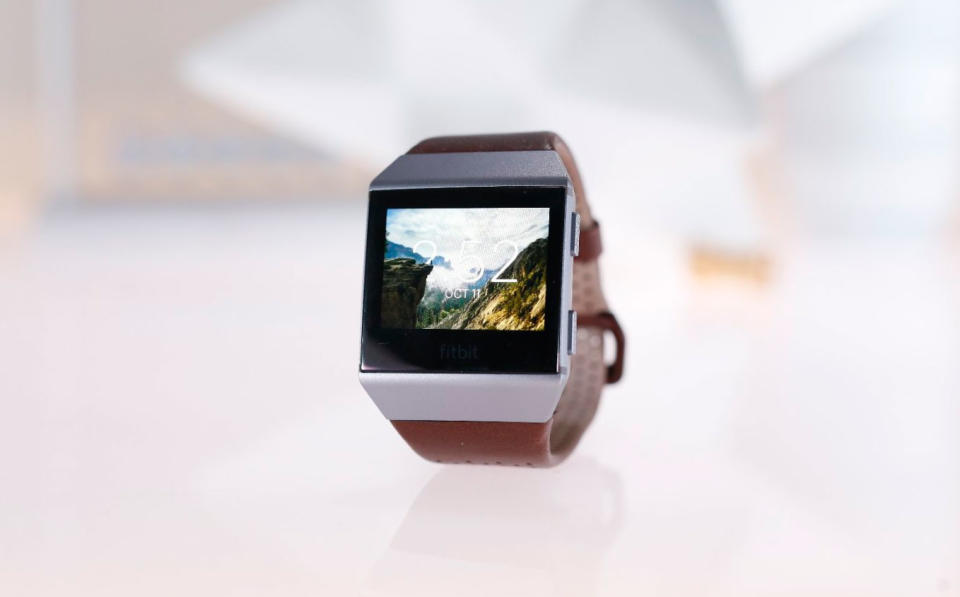Fitbit Ionic review: Good fitness tracker, passable smartwatch
In a rush to your wrist, the company made some questionable choices.
Fitbit's first real smartwatch was the worst kept secret in tech. After months of rumors, leaks and the acquisition of smartwatch pioneer Pebble that all but revealed the company's intentions, Fitbit presented the Ionic to the world. It was a promising debut, featuring a shiny new operating system built with Pebble's expertise. The company also unveiled its own contactless payment system meant to make running or working out without a phone feel more feasible.
This is Fitbit's most ambitious launch in years, which is timely given that 2017 marks the company's tenth anniversary. But it's also overdue. The Fitbit Ionic arrives at a time when the definition of a smartwatch is coalescing. The Ionic feels more like a fitness tracker with just enough smartwatch features to justify calling itself one, but doesn't have the full functionality we've come to expect from the category. Still, the Ionic does make some sense, as long as you aren't expecting a complete suite of smartwatch features.
Hardware
I've said it before, and I'll say it again: The Fitbit Ionic looks a lot better in person than it does in pictures. That doesn't mean it's pretty, though. The Ionic's geometric design and squarish face make it hard to dress up, even when I swapped out the default gray strap for Fitbit's brown leather band. In fact, I find the leather band with "Cognac" finish uglier than the original -- its coppery brown tone and perforated texture lack the class of a plain leather band and doesn't match the gray face. At least it's easy to switch the straps out for something more attractive.
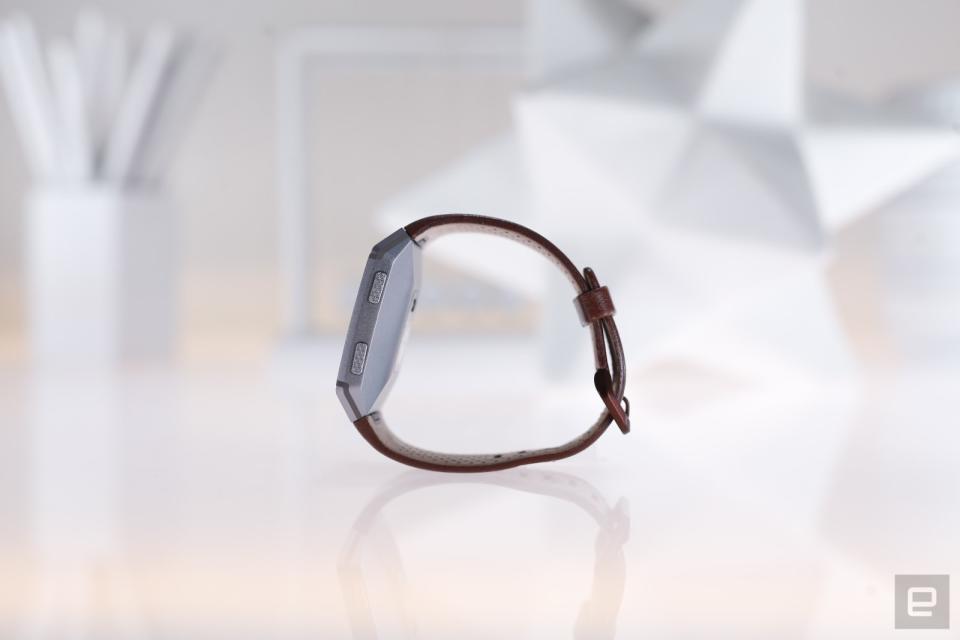
That said, Fitbit designed the Ionic to fit aesthetically with the rest of its products, and there's no mistaking this smartwatch for one from any other brand. Like the company's previous Blaze and Surge watches, the Ionic is a fitness tracker masquerading as a smartwatch, and I'm not just talking about looks. But more on that later.
First, I have to give Fitbit props for improving the Ionic's overall fit. While the Charge 2, Alta and Flex 2 have cylindrical modules with straight surfaces, the Ionic's body and screen are subtly curved. Because of this, the watch hugs my wrist better than the company's other trackers, which helps keep the heart rate sensor in place during workouts and during sleep.
My favorite thing about the Ionic's hardware, though, is its brilliant display. Like I said before, the 1.42-inch, 348 x 250 screen is sharp, colorful and bright enough to read in direct sunlight, which makes up for my disappointment in the fact that it's not round. The display is also responsive and doesn't lag when I swipe through menus and lists of notifications. Overall, the latest Fitbit feels at once familiar and refreshing, thanks to its beautiful screen and premium build quality.
In use
There's really not much more to go over that I haven't already covered in my hands-on and 24-hour "first look" pieces. The biggest news is that since my last article was published, Fitbit Pay has gone live. It's one of a few features Fitbit recently added to the Ionic to ease anxiety about leaving your phone at home while you're working out.

Now that Pay is live, you can add your debit or credit card via the Fitbit app on your phone. (Visa, Mastercard, Amex and a growing number of major banks are supported.) Fitbit Pay is accepted anywhere that takes NFC transactions. For security, you'll be asked to set a four-digit PIN that you'll later use to verify each payment and unlock your watch if you've removed it from your wrist.
I loaded a debit card on the watch (you can save up to six and set one as the primary option) and used it to buy sheet protectors at the Staples across the street. It was as easy as using Apple Pay on my phone, except I had to enter the PIN before authorizing the transaction rather than authenticate with Touch ID. Still, that's a minor inconvenience for the benefit of knowing I can leave my phone behind and not be stranded if I need to buy something.
Another useful addition is the ability to play music from the watch's 4GB of onboard storage. There are two ways to do this: via the Pandora app (if you have a paid Premium account) or transferring files from your PC. Both methods have their drawbacks and aren't easy to set up. The Pandora app on the watch takes forever to sync playlists that I select from the phone, causing me to wonder if it was successful. After it syncs, though, Pandora generally works well.
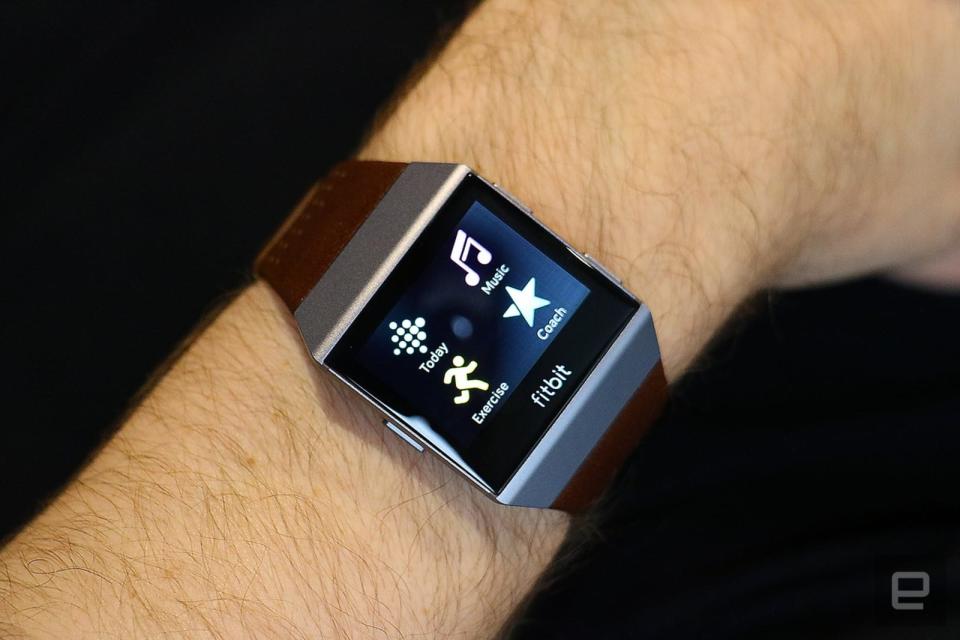
As I described in my preview, Fitbit's system took an excruciatingly long time for my laptop and Ionic to find each other. You also had to manage your music by using Windows Media or iTunes playlists, which isn't very intuitive. Since then, the company has updated its Windows app so users can manage individual tracks directly in the app. You can drag and drop music files into the Fitbit window or browse your computer's storage to add songs. This was a welcome improvement that made it easier to transfer files. Kudos for making this change, Fitbit.
Like any smartwatch worth its salt, the Ionic delivers notifications to your wrist. But unlike many of its rivals, the Ionic doesn't allow you to reply to them. That's strange, considering Pebble watches managed to let you reply to messages (even with your voice in some cases) if you're paired to an Android or an iPhone.
The preview of each alert that comes to your wrist is usually sufficiently long -- I always saw all the contents of the tweets or texts I received. For emails, though, the alert is often truncated right after the subject line, which is useless at times.

Then there are the apps (or lack thereof). Fitbit pre-installs about a dozen to start you off, including alarms, weather, music, timers and Today (which shows you a snapshot of your progress toward daily step and calorie goals). Third-party apps available at launch include Pandora, Strava and Starbucks. These are useful, but the relatively sparse offerings makes me feel like I'm in a library where the shelves are mostly empty and all the books I want are missing. I'm still waiting on offerings from Yelp, Uber and Foursquare, which had apps for the Pebble watches back in the day, and were some of the earliest to get on board. Such apps would go a long way in making the Ionic feel more like a real smartwatch.
Smartwatch ambitions aside, the Fitbit Ionic is a capable fitness tracker. I used it to track 20-minute sessions on a stationary bike, during which I compared its readout with the heart rate data on the watch. The Ionic was usually within 2 bpm of the bike, unless I sped up and my pulse jumped drastically. Then, the Ionic would lag the bike in noting the increase. This delay is problematic for people who pay attention to the cardio zone they're in while working out, since it affects the amount of time you record in each zone, but the Ionic does eventually catch up and the difference often evens out.

I still like the new Coach feature, which guides you through workouts on your wrist. During this round of testing, however, I was frequently interrupted by incoming message alerts. After each set, the Ionic buzzes to let you know that you can stop and move on to the next exercise. But notifications from my chatty friends caused similar buzzes, which led me to think that my set was over when I still had more reps to complete. Although you can turn notifications off manually, it'd be better if Fitbit disabled incoming alerts by default when a workout session was in progress.
The Ionic's sleep tracking is more reliable than previous Fitbits, thanks to its snugger fit. The data gleaned and presented in the app remains as useful as it was before, which is -- not very. What I've learned from my days of wearing the Ionic to bed is that I tend to spend more time in the REM stage than other women my age. It took me about an hour of Googling to realize that researchers still don't necessarily know how much sleep in each stage is ideal. I found out through my own digging that REM sleep is thought to be when the brain heals and forms memories, so I decided (very unscientifically) that my higher-than-normal time in that stage meant I must remember more than others.
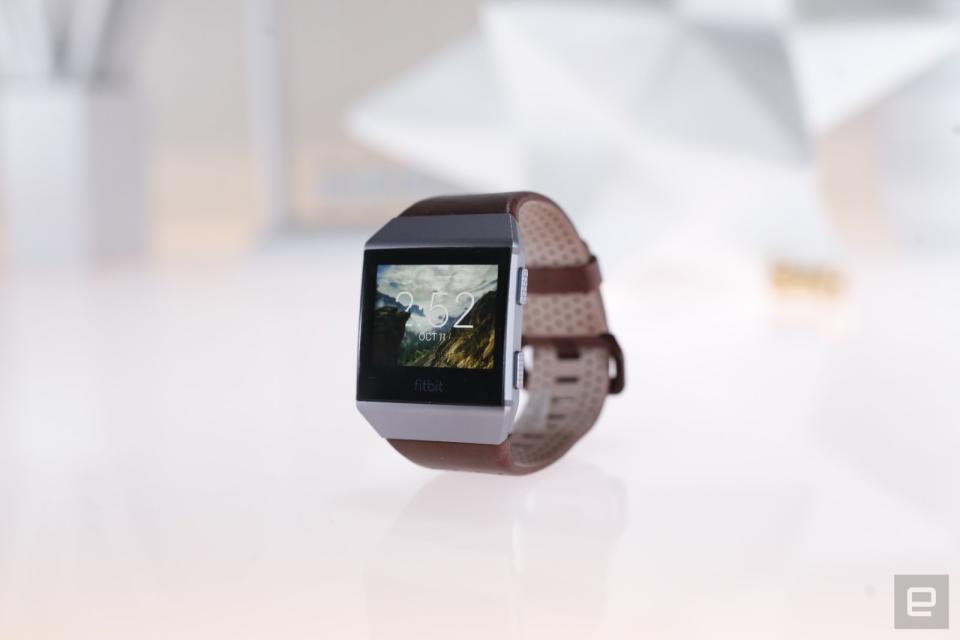
The point being, I really shouldn't need to spend all that time on Google to find out what I did. Fitbit could have easily told me, inside the app, what REM sleep is thought to improve while cautioning that sleep-stage studies have been inconclusive. Instead, it shows me how I performed relative to my previous nights and others my age. That's still more than the information you can get from competing trackers, though, which at the moment still don't use the heart rate monitor to understand what stage of sleep you're in.
Here's my biggest problem with the Ionic. Trying to get any of the new features to work often involved a frustrating update process. It took hours to complete the firmware update with Fitbit Pay. When I tried to set it up, I was told my WiFi connection (to the watch) was broken so I had to use Bluetooth instead. After agreeing to that, I was warned the update could take up to 10 minutes.
Ten minutes later, I was running late for a meeting and according to the progress bar on the watch, the Ionic was only a third done. I decided to run out mid-update, hoping that the Bluetooth connection wouldn't be interrupted as I made my commute. No such luck; the update stalled. Two hours later, I had to reset the connection between my phone and the watch to re-initiate the update. Fifteen minutes after that, the Ionic update as finally complete.
Delays like this are less of an issue if the updates are infrequent, but since some of the Ionic's key features have yet to be released, users are likely to endure this time-consuming process again sometime soon. For example, the watch's SpO2 blood oxygen monitor isn't being used at the moment as Fitbit figures out how to implement it, but once that feature is activated, Ionic owners will presumably have to update their firmware.
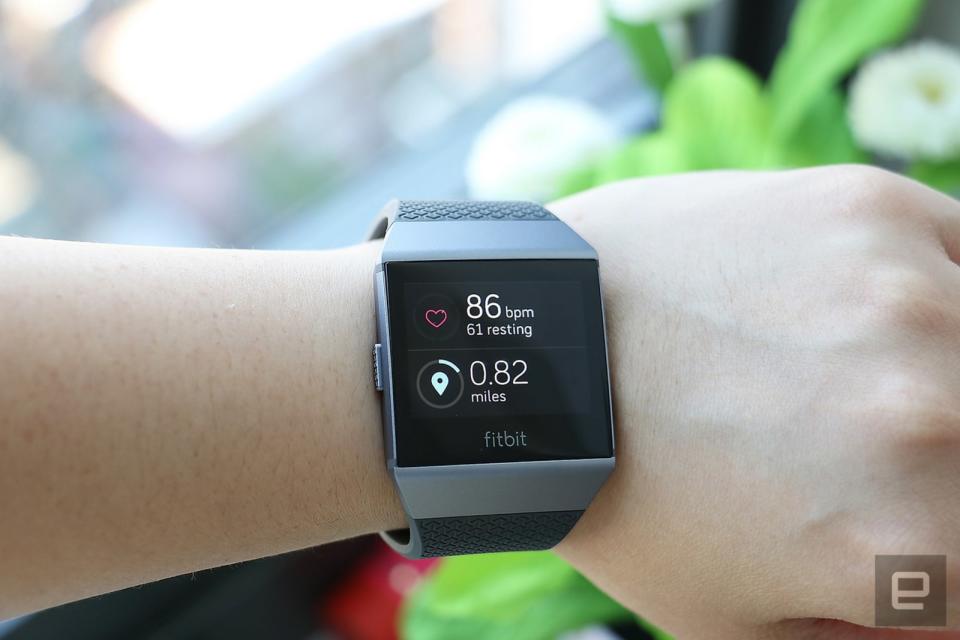
Then in 2018, the company is launching the Guided Health programs, which will create customized workout and health programs for each user, as well as push audio exercise instructions through the watch to paired earbuds. These sound like compelling features that I'd like to make use of, but I'm already bracing myself for the potentially long wait time to get them working. Fitbit needs to figure out a way to make its device updates less painful if it's going to keep launching products before all the features are ready.
Ultimately, what's available now works well, and while Fitbit struggles to get the Ionic's smartwatch functions right, the company continues to excel at fitness-tracking features. The Ionic's long-lasting battery, which generally got through five or six days before needing a charge, is perhaps its best feature,and beats basically every other product in the category.
The competition
This is the year every major player in the fitness wearables industry decided to make a $300 smartwatch. Apple, Samsung and Garmin each launched fitness-minded smartwatches this year, and almost all of which support third-party apps, contactless payments and offline music playback.
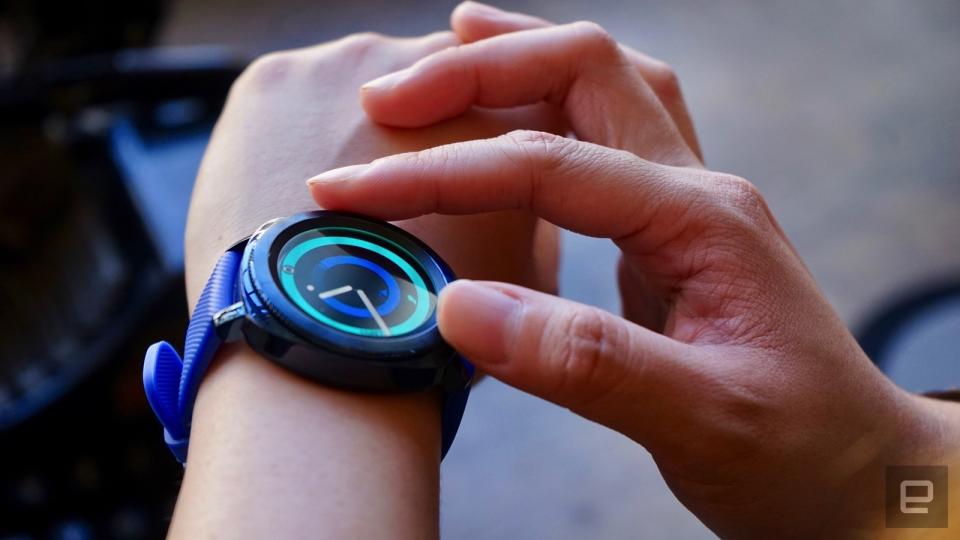
Unlike the Ionic, the Samsung Gear Sport and Garmin Vivoactive 3 have round faces, while the Apple Watch 3 has a rounded-square shape. If you want something that looks more like a traditional timepiece, Samsung and Garmin's offerings are better options. iPhone owners will understandably be tempted by the Apple Watch 3, even though it's slightly more expensive at $329 (and that's without LTE). The Apple wearable lets iOS users reply to messages, interact with Siri and offers an abundance of useful apps -- all things that the Ionic lacks. But if you're already heavily invested in the Fitbit ecosystem, perhaps from having used an older device, you might prefer the Ionic.
The Gear Sport, on the other hand, is a good option for those who own Samsung's TVs, phones or a Smartthings hub, as the watch offers additional features when paired with those devices. The Sport is not only waterproof up to 50 meters, but will also withstand immersion in saltwater. It runs the company's Tizen OS, which now boasts thousands of apps including Spotify, WhatsApp, Facebook and Instagram.
Like the Ionic, the Gear Sport can also track your swims, but it goes one step further and measures your heart rate even when it's underwater. Better yet, the Gear Sport works with Samsung's assistant, Bixby, to answer your questions or help you compose messages, and you can reply to notifications from your wrist. From a brief hands-on in August, the Gear Sport's screen appears just as bright and crisp as the Ionic's, but we can't totally vouch for the Gear Sport since we haven't fully tested it.
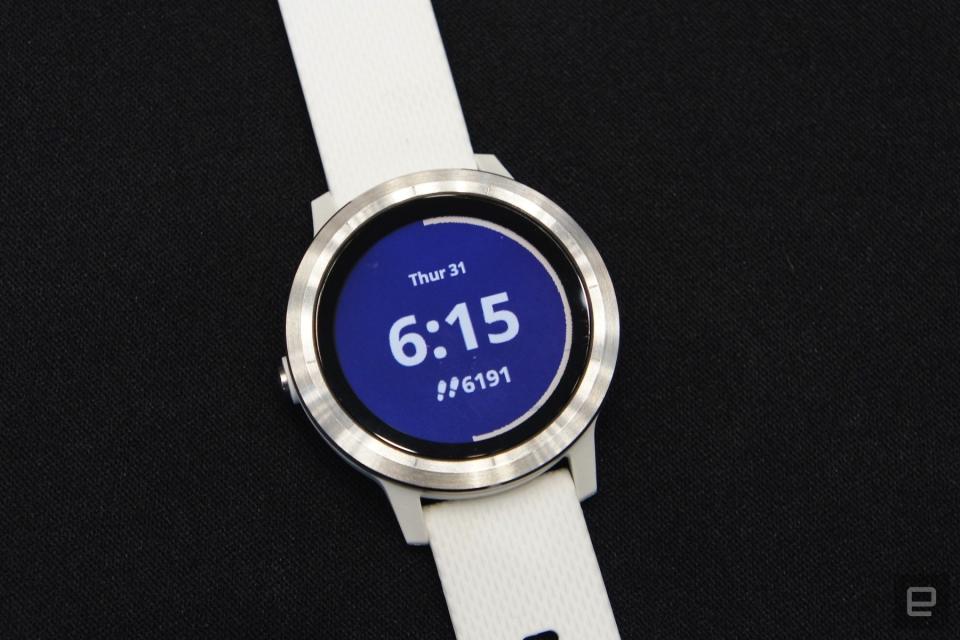
Runners might prefer the Garmin Vivoactive 3, which uses the company's own basic smartwatch OS, and it supports more apps than the Ionic does at the moment. Garmin's device can track more types of exercises and has an established reputation as a leader in GPS technology, so it's likely to be best at mapping your runs. Plus, its estimated runtime of seven days makes the Garmin watch the only device on this list to outlast the Fitbit. But the Vivoactive 3's transflective "memory-in-pixel" screen looks more like a color e-Ink display and is less impressive than the Ionic's LCD panel. To be fair, we haven't tested the the Vivoactive 3 and can't vouch for its performance and battery life.
Each of the above options has its own strengths, but if you're looking for something long-lasting with well-rounded fitness-tracking features, the Ionic is a good option.
Wrap-up
Ultimately, the Ionic is a respectable debut for Fitbit's first serious attempt at a true smartwatch, and the company continues to excel at fitness-tracking features. But while its new operating system is intuitive and well-designed, overall the device still feels like a placeholder. Fitbit wanted to secure the Ionic's spot on your wrist this holiday season before it was completely ready.
As it stands, the Ionic is a capable fitness tracker with some passable smartwatch features. It's clear that Fitbit will continue to improve its software, but the magic it needs for the Ionic to seriously contend real smartwatches is faith. Faith from the app makers who were so enthusiastic about Pebble OS and developed hundreds of offerings that made the pioneer smartwatch not only useful, but a lot of fun. Until that happens, the Ionic is simply functional.
